Expert’s Rating
Pros
- Upgrades to the CPU and GPU provide very respectable performance
- The display is both graphically impressive and exceptionally smooth
- Price-wise it beats some competitors
Cons
- The keys feel a bit mushy
- It lacks a dedicated LAN port relying instead on upgrades to wireless connectivity
- The styling is quite modest
Our Verdict
With enough grunt to produce respectable frame rates at 2560 x 1600 resolution, and a gorgeous and smooth 16-inch Mini LED display, the 2023 ROG Zephyrus M16 raises the bar yet again for Zephyrus fans.
Best Prices Today: Asus ROG Zephyrus M16

$1949.99
Asus’s original ROG Zephyrus M16 made powerful performance a real possibility in a slim and light 16-inch gaming laptop, and while the 2023 M16 doesn’t quite reinvent the wheel here, remarkably, and despite some very decent upgrades, the new model holds firm to that principle, just about equaling the size and weight of its more recent forebear.
Indeed, Asus have taken a more conciliatory approach to this year’s M16, keeping the bones of the laptop intact while building upon key performance hardware – improving the power output with 13th-gen Intel and Nvidia RTX 40 Series chips, ramping up the TGP to 140 watts and my favorite new addition, changing out the IPS QHD+ display to be a QHD+ Mini LED panel clocked at 240Hz. If that’s not enough for you to hit the trigger on it, you may take solace knowing the M16 is one of the more affordable mid-range laptops in its class.
Looking for more options? Check out PCWorld’s roundup of the best gaming laptops available right now.
Asus ROG Zephyrus M16: Specs and features
You can find three variants of the Asus ROG Zephryrus M16 at Asus’s online store, each sporting an i9-13900H processor but with different RTX 40 Series GPUs or other varying components. My review unit with its RTX 4070 is currently the most affordable of the bunch, retailing for $1,949.99 at Best Buy, while a top-line variant with a souped-up RTX 4090 GPU will cost you $3,499.99 USD at Asus Online.
Scouring the field of other 16-inch laptops for price comparisons, our model’s $1,949.99 sticker price skims more than a $1,000 USD off the price of a 2023 Razer Blade 16, which ships with the same RTX 4070 GPU (for $2,999.99) but with a more premium Intel i9-13950HX CPU.
The 2023 Lenovo Legion Pro 7i makes a closer comparison, with one model featuring an Intel i9-13900HX CPU and identical GPU as my review unit’s and yet the M16 is still slightly cheaper. The Lenovo currently costs $2,175, which is $200 more. The exact specifications of this particular M16 review unit are as follows:
- CPU: Intel Core i9-13900H
- RAM: 32GB DDR5 / 4800Hz
- GPU: Nvidia GeForce RTX 4070
- Display: 16-inch QHD+ (2560×1600), Mini-LED, 100% DCI-P3 color gamut, 16:10 ratio, 240 Hz refresh rate, 3ms response rate, Pantone Validated, MUX Switch and Advanced Optimus, G-sync
- Storage: 1TB NMVe PCle Gen 4 SSD
- Ports: 2 x USB-A 3.2 Gen 2, USB-C 3.2 Gen 2 (DisplayPort and Power Delivery), Thunderbolt 4, HDMI 2.1, 3.5 mm combo audio jack
- Networking: Wi-Fi 6E(802.11ax), Bluetooth 5.3
- Weight: 4.63 lbs (2.10kg)
- Dimensions: 13.98 x 9.69 x 0.78 inches
- Webcam: 1080p FHD IF camera, Windows Hello
- Battery Capacity: 90WHrs
- Price: $1,949.99 (with 16GB) from Best Buy
Asus ROG Zephyrus M16: Design and build
This year’s Zephyrus M16 boasts next generation CPU and GPU upgrades that push the power envelope further, yet impressively its proportions remain the same as in 2022. It measures a precise 3.98 x 9.57 x 0.78 inches which fits last year’s Zephyrus M16 chassis like a glove. A tiny weight gain of 3.52 ounces means it’s only slightly heavier year-on-year, so you won’t need to double what you bench-press at the gym.
The size of the display too is mostly unchanged from last year, meaning it’s big and gorgeous and a stunning sight to behold. It’s still exceptionally tall thanks to its 16:10 aspect ratio, which means there’s extra eye candy for movies or just catching up on a little work or gaming. Personally, I was super stoked that I could finally actually see those tiny war elephants in Age of Mythology: Extended Edition that I usually have to squint to see.
”the M16’s QHD+ (2560 x 1600) Mini LED, is in every way the epitome of a bright, immensely colorful but also remarkably smooth gaming panel
The ultra slim bezels and the extra low-set hinges really carry the laptop here, doing wonders to frame the display up as splendidly as can be, such that the M16 can boast a whopping 92 percent screen-to-body ratio, which is no mean feat of engineering.
But alas there are other meaty changes to be found in this year’s M16. For one, the HDMI port has been upgraded from a HDMI 2.0 to HDMI 2.1, so it benefits from the much higher 48Gbps bandwidth. The new model also ships without a LAN port, relying instead on wireless connectivity upgrades in the form of Wi-Fi 6E and Bluetooth 5.3 – the fastest currently available. Suffice to say, excellent wireless even of this caliber isn’t quite a replacement for a quick reliable LAN connection, so this is kind of a sore point with me.
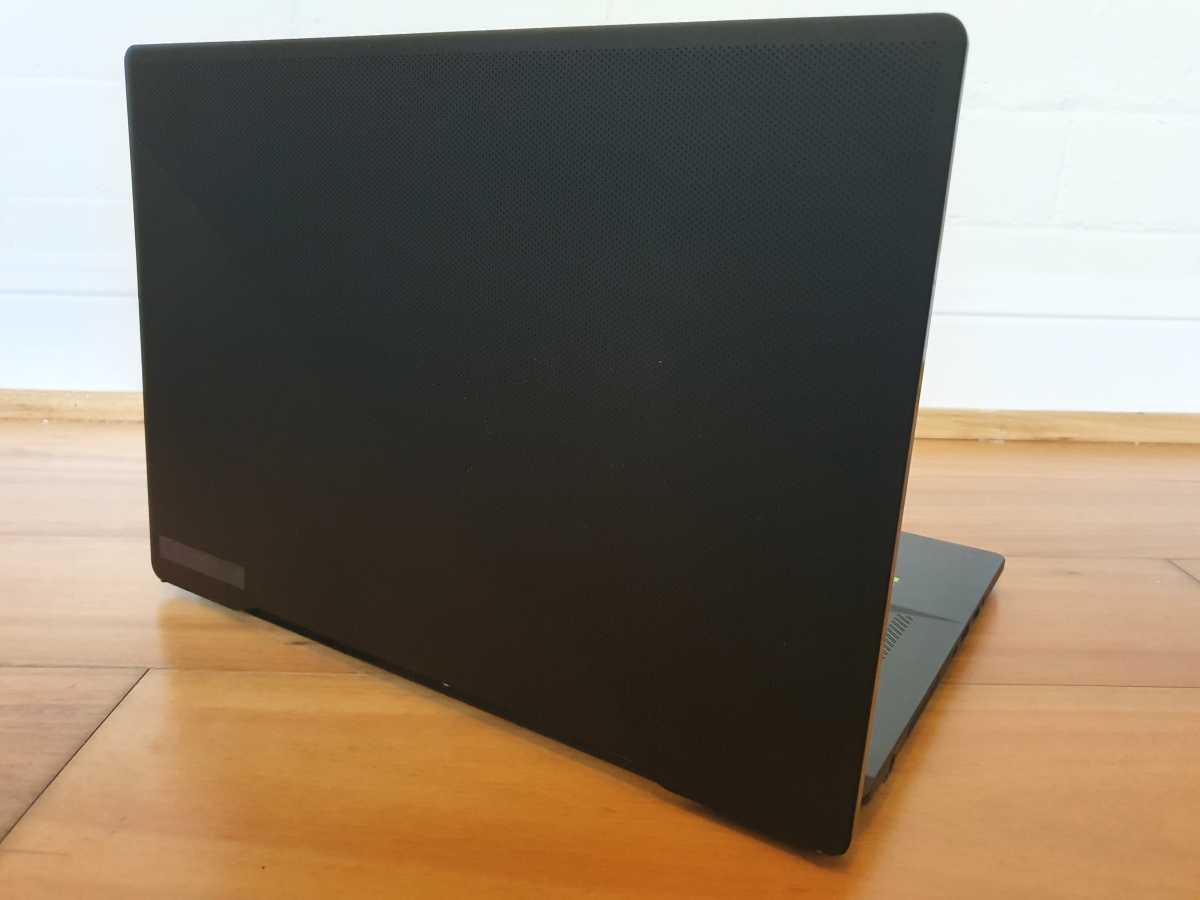
The Asus ROG Zephyrus M16’s top cover has over 18,000 tiny perforations that you can light up in models that have the AniMe Matrix feature. Shown here: our review model without this feature.
Dominic Bayley / IDG
Still, the port selection is very good. You get multiple USB-C and USB-A ports to play with, so I never had an issue finding an outlet for a favorite mouse, external keyboard, or USB dock. One of the USB-C ports is a Thunderbolt 4 port, which I quickly made use of to transfer excessively large games, like the 100GB plus Elden Ring, which I’d rather watch paint dry than sit and wait to download.
For styling, my M16 looked a little understated up against its flashier 2023 stablemate the 16-inch Asus ROG Strix G16, which I happened to be testing at the same time. It eschews features like the G16’s blinged out RGB light bar at the front and transparent cyber punk keys, in favor of a plain front and single-color Backlit Chiclet keyboard. The M16 comes in just one color, too – black – so the whole thing looks remarkably modest.
That is, my model looked modest – being the variant that shipped without a feature called AniMe Matrix. This feature lights up the 18,710 machined perforated holes in the M16’s lid to create a dazzling LED light display, although it only comes in some variants, so it’s worth checking before you buy if you do want to add some razzle dazzle to the styling.
Asus ROG Zephyrus M16: Keyboard and trackpad
The M16’s trackpad fit snugly in the chassis, providing ample space for my arms to assume a relaxed typing position. That kept me comfortable through one of the longest quest chains in WoW Classic: Wrath of the Lich King I’ve ever done – Escape the Lich King’s grasp. Additionally, the trackpad felt soft enough for all day use and made hardly any sound, which was ideal for a sly gaming sessions in the library.
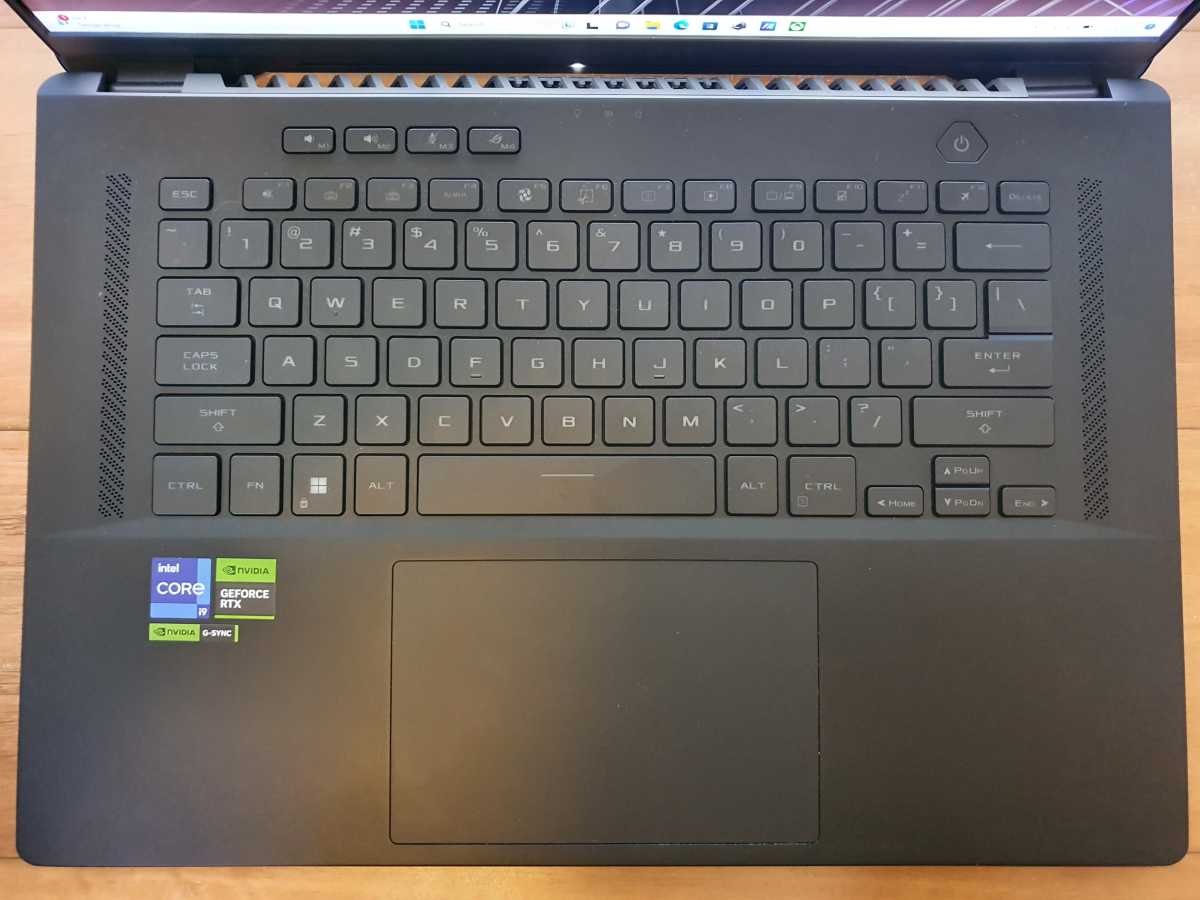
The Asus ROG Zephyrus M16’s keyboard and trackpad are very well proportioned for comfortable typing.
Dominic Bayley / IDG
The keyboard has both merits and pitfalls, in that it’s reasonably well sized, but the keys feel a little too mushy to be truly comfortable. For one, they’re quite low set into the keyboard already, but drop down a quarter inch more when you press them and don’t rebound well.
The layout is perfectly fine for all your gaming needs, however, being the standard type you’d expect on a 16-inch laptop. It lacks a dedicated numpad, but provides all the Fn keys as well as go-to gaming favorites like Left and Right Shift keys. You do get useful media keys at the very top and conveniently the function keys double as handy short cuts, which saved me a ton of time both in Windows and in my games for doing things like taking quick screenshots.
Asus ROG Zephyrus M16: Display, audio
While we’re beginning to see OLED displays pop up in gaming laptops these days, when it comes to performance for me it’s hard to overlook something like the M16’s ROG Nebula HDR Mini LED display which in my opinion hit the right balance between gorgeous imagery and buttery smooth motion. OLEDs make me a little anxious too since burn-in became a thing to worry about on laptops, but as a Mini LED there was no need to worry about that.
To be sure, the M16’s QHD+ (2560 x 1600) Mini LED, is in every way the epitome of a bright, immensely colorful but also remarkably smooth gaming panel. With its tiny diodes that measure just 0.2 milimeters in diameter, it hits an impressive peak brightness of 1100 nits, and has a contrast ratio of 100,000:1, which is not just a metric – it’s something you’re really going to notice.
Suffice to say, the quality of images I got on the 100 percent DPI-P3 panel hit home immediately in a game of Red Dead Redemption 2 where images appeared brighter and more saturated than I’ve seen them in 16-inch rivals. Darks also looked true and immensely deep. I cross reference a lot of laptop displays and the colors appeared incredibly accurate, too – hence the panel’s VESA Display HDR 1000, Dolby Vision and Pantone certifications.

A The Elder Scrolls V: Skyrim screenshot taken on our review unit’s QHD+ ROG Nebula HDR display.
Dominic Bayley / IDG
But what really sold me on the M16’s display was how fluid fast moving action appeared. Legacy technologies return in a big way to make that a reality – no less than a quick three millisecond response time, G-Sync, and a very fast 240Hz refresh rate. In regards to the latter, that’s an upgrade from the 165Hz rate we saw in 2022, which I’m very happy about.
When it comes to audio, the M16 is no slouch either; it outdoes a contingent of rival mid-range laptops thanks to a well-placed smattering of not four, but six speakers powered by Dolby Atmos. These do remarkably well to produce a sound profile that balances out nicely across the tonal spectrum, with reasonably deep-sounding lows and highs that pop through the speaker grilles clearly without sounding like they’re getting shattered by chassis vibrations.
Asus ROG Zephyrus M16: CPU performance
My review unit featured an Intel 13th-gen Core i9-13900H mobile processor which packs in a total of 14 cores. This chip, which belongs to Intel’s Raptor Lake series, and is especially designed for lightweight enthusiast gaming laptops, advances Intel’s hybrid chip architecture to leverage 8 Efficient (E-Cores) and 6 Performance Cores (P-Cores) with a maximum of 20 Threads. Intel’s benchmarks show it has a maximum turbo frequency of 5.4 GHz per each of its performance cores – which really pushes the upper limits of CPU performance capabilities.
To find out where exactly in the PCWorld’s panoply of mid-range gaming laptops the M16’s CPU sat, I pulled comparisons from our 2022 gaming review charts, including laptops like the Asus ROG Zephyrus Duo 16 with its AMD Ryzen 9 6900HX CPU, but I also added in 2023 laptops like the Razer Blade 16 which features a Core i9-13950HX CPU.
First CPU test off the blocks was Maxon’s Cinebench R20 Multi-Threaded benchmark, a test that utilizes every core of the laptop’s CPU. In our benchmark results you can see the M16’s CPU squeezes every ounce of CPU power it can to hit a score of 7,352 – an impressive result which bested even the Razer Blade 16 among our comparisons.
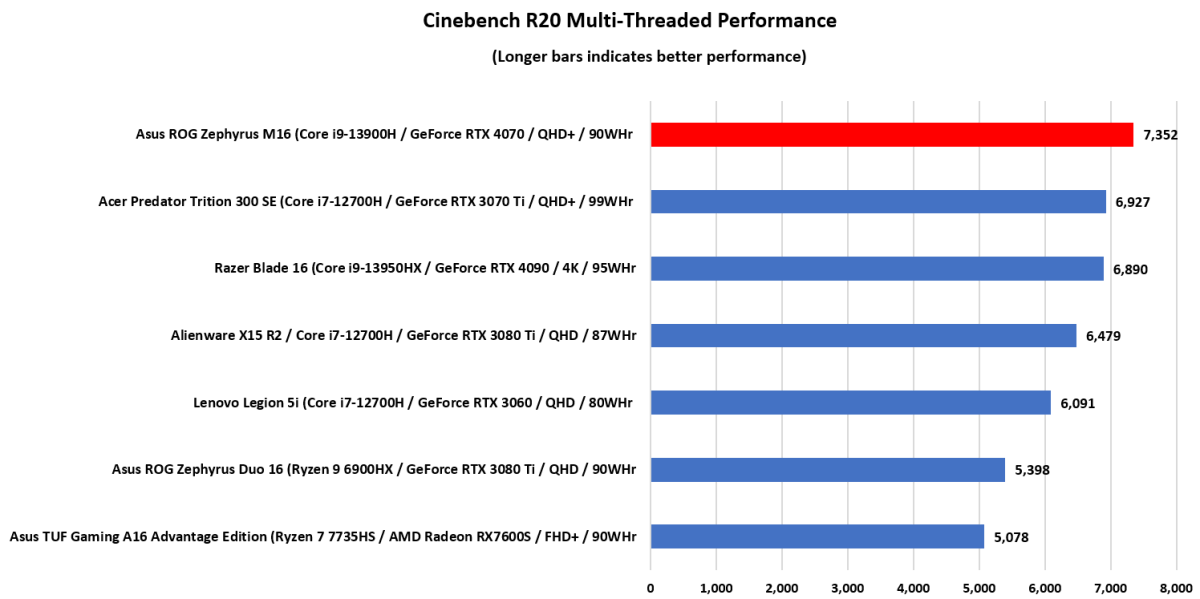
Dominic Bayley / IDG
Based on this result we can confidently say that the Intel i9-13900H is a powerful performer in the context of the M16, which in turn means it should easily power the latest AAA games and just as easily breeze through CPU-intensive tasks like encoding or video editing.
Following this, I looked at how well the M16’s CPU could keep processing data faced with rising thermals. Would it need to throttle performance to keep overheating at bay, or keep up the pace to finish tasks at breakneck speed? To find out I ran a bespoke test designed specifically for the free HandBrake utility – with the objective being to see how quickly the laptop could finish encoding a 30GB MKV file to MP4 using the Android Tablet Preset.
As you can see in the graph below, the M16’s i9-13900H processor did remarkably well, defeating most of the comparison field. Put simply, this means the M16 is unlikely to put the brakes on too much when the laptop heats up, which is a great news for gamers that really need consistent performance.

Dominic Bayley / IDG
Asus ROG Zephyrus M16: Gaming performance
Moving enough frames on a 2560×1600 display for decent gameplay is no mean feat – in fact, it’s one of the reasons many gamers often opt for a 1080p panel instead. Consequently, I was very keen to see if the M16’s RTX 4070 GPU – one of Nvidia’s powerful new mid-range graphics cards – could do just that.
The mobile RTX 4070 is essentially 2023’s answer to last year’s mobile RTX 3070, in that it’s meant to be the option that gamers on a budget can turn to for solid power at a still affordable price. Looking at its specifications, this GPU sports 4608 Cores, 144 of which are Nvidia Tensor Cores, designed to help improve the speed of machine learning applications. It also has 36 ray-tracing cores, which render texture and shadows better in 3D graphical applications – so theoretically, it’s well equipped for the latest games.
3DMark’s Time Spy 1.2 benchmark was my go-to performance benchmark to gage the GPU’s graphical performance. This DirectX 12 benchmark for Windows 10/11 PCs, is especially designed to support new API features like asynchronous compute, explicit multi-adapter and multi-threading, so it’s ideal for evaluating Nvidia’s latest GPU releases.

Dominic Bayley / IDG
As you can see in the results, my laptop’s GPU hit a high of 11,862 in the benchmark’s ‘Overall’ category, which all things considered, wasn’t far off what the Razer Blade’s RTX 4090 GPU hit. This result proves the RTX 4070 is a stellar option in the M16 and implies that it’s quite capable of tackling the most graphically demanding tasks – be that games, video editing, or 3D rendering.
While the Time Spy 1.2 benchmark provides a scattergun glimpse of the GPU’s capabilities, it doesn’t really provide any information about the kinds of average frame rates you’re likely to get in games. Next up, I ran the Rise of the Tomb Raider gaming benchmark. Here we see the M16’s GPU outpaced the majority of laptops – showing quite considerably faster average frame rates than laptops with older Nvidia RTX 30 series GPUs.
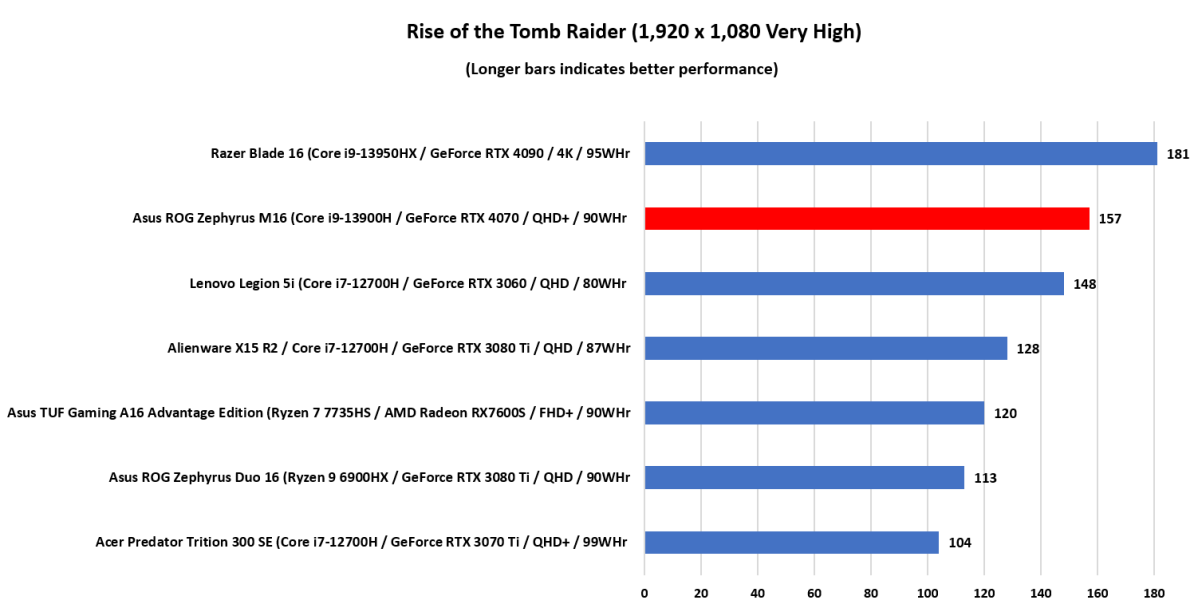
Dominic Bayley / IDG
Last but not least, the results of our benchmark for the game Shadow of the Tomb Raider are reasonably consistent with the two tests we completed above. While it’s true that the Razer Blade 16 again has the edge on the M16 – yet again the M16 isn’t far behind, which is testament to the kind of graphics power this machine can produce.
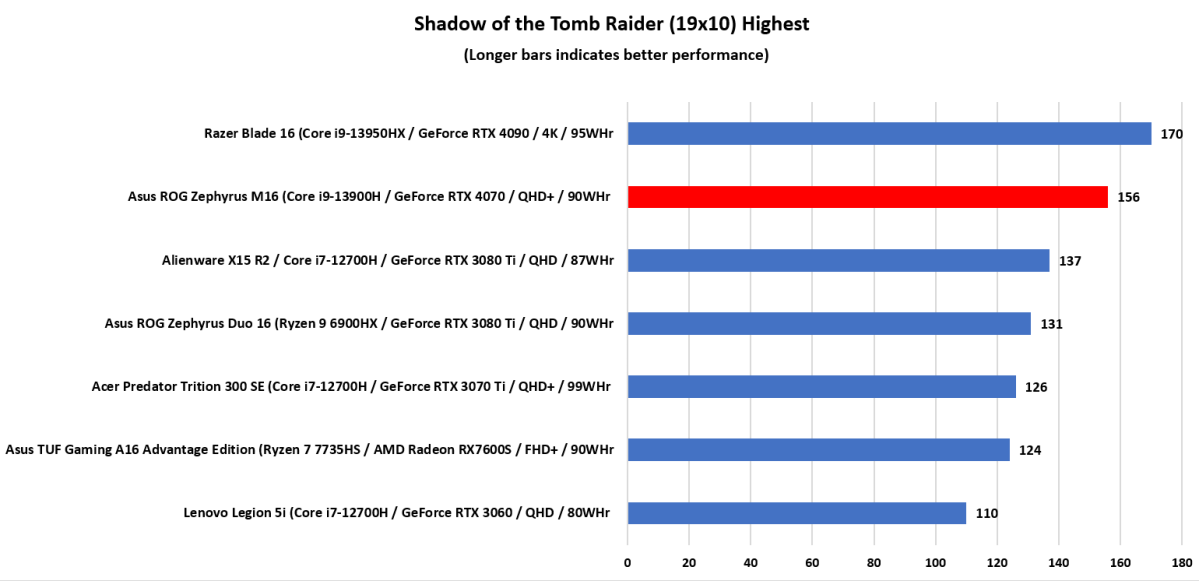
Dominic Bayley / IDG
Asus ROG Zephyrus M16: Battery life
The M16 featured a large 90Whr battery, but we’ve seen before that large batteries don’t always equate to better performance. So, to test just how long it would last, I applied PCWorld’s in-house battery test, which meant I ran a Hollywood movie on repeat at 50 percent volume with a pair of cheap headphones inserted to keep sound to a minimum. With the keyboard backlighting turned off, the M16 lasted almost eight hours before the battery died.
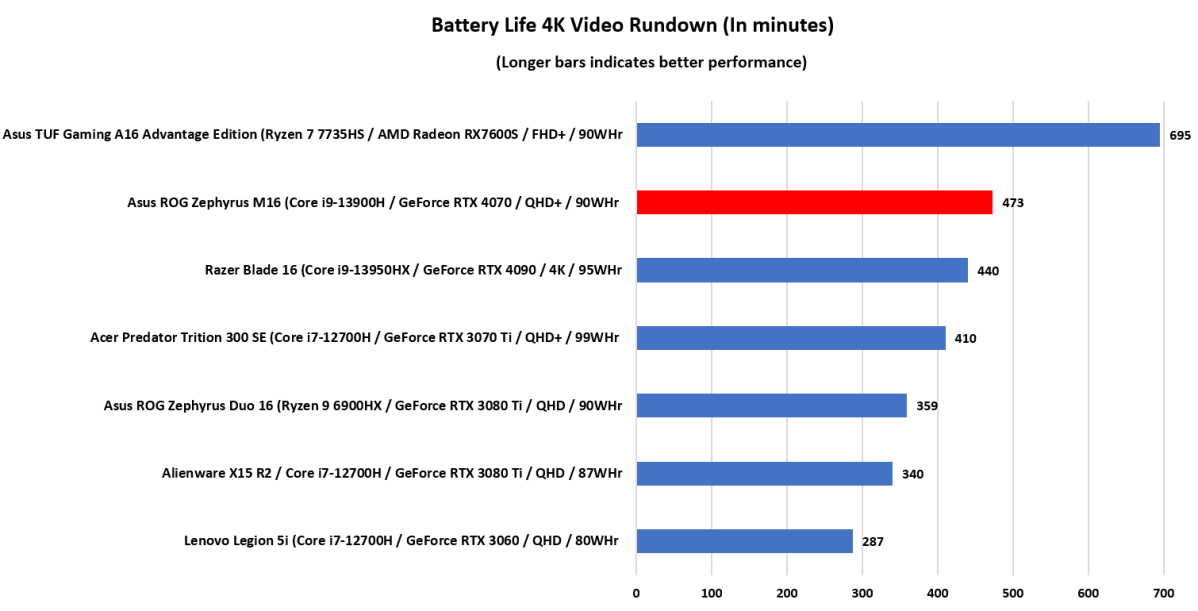
Dominic Bayley / IDG
That’s not the best I’ve seen this year – the Asus TUF Gaming A16 Advantage Edition holds that title at more than 11 hours, but it’s one of the better results and nothing to sneeze at either. That means in a real-time gaming scenario, you can expect about four hours of gaming time away from an outlet before you’ll need to plug back in and recharge.
Asus ROG Zephyrus M16: Should you buy it?
While the 2023 Zephyrus M16 does a novel thing with the Zephyrus brand, focusing more on decadent power upgrades than continuing the trend towards a lighter and thinner chassis – this change nevertheless actually makes it one of the best 16-inch options in 2023.
For gamers looking for a reasonably light and portable laptop that’ll produce quick frame rates at 2560×1600, it’s very hard to look beyond the M16. What’s more, you can expect to pay a little less than some competitors for the privilege. While a mushy keyboard and more modest styling may be irksome for some gamers, this laptop gets everything mostly right, which is no small feat.




